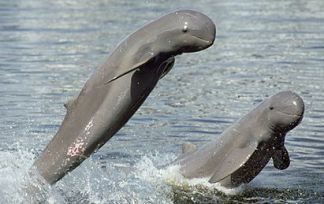Ganges River Dolphin (Platanista Gangetica)
Recently, Ganges River Dolphin (Platanista Gangetica) was tagged in Assam for tracking down of these dolphins for studying the wildlife conservation. Read more about Ganges River Dolphin below......
About Ganges River Dolphin

- Ganges River Dolphin is regarded India's National Aquatic Animal since 2009.
- It is also regarded as State Aquatic animal of Assam.
- Its scientific name is Platanista Gangetica.
- It is commonly called as Susu due to the sound that its emits (Su...Su....Su...Su) while breathing on the water surface.
- It is also known as Tiger of Ganges as it is an ecosystem indicator species.
- Its species are distributed across the Ganga-Brahmaputra-Meghna and Karnaphuli river systems.
Protection Status
- IUCN - Endangered.
- CITEX - Appendix - I.
- CMS - Appendix - I.
- Wildlife Protection Act, 1972 - Schedule - 1.
Features of Ganges River Dolphin
- Can only survive in Freshwater.
- Cannot breathe under the water and have to surface for 10-30 seconds.
- Nearly blind and rely on echolocation for their biological needs, emits ultrasonic sounds to hunt that bounce off prey, creating a mental image for navigation and feeding.
- Physical Features -
- Long, thin snout, a rounded belly, a stocky body, and large flippers.
- Has a blowhole-like slit on top of its head, functioning as a nostril.
- Females are larger than males and give birth to one calf every 2-3 years with a gestation period of about 10 months.
Types of Ganges River Dolphin
| River Dolphin Species | Distribution | Key Features | Conservation Status |
|---|---|---|---|
| Ganges River Dolphin | Ganges River and its tributaries in India, Nepal, and Bangladesh | => Long and slender beak
=> blind and use sound waves => pink or gray in color => Survive or live in Freshwater |
Endangered |
| Indus River Dolphin | Indus River in Pakistan | => Similar to Ganges River Dolphins but smaller
=> Survive in Murky river water |
Endangered |
| Irrawaddy Dolphin | Irrawaddy River and coastal waters of Southeast Asia and Chilika lake, Odisha | => Short and Blunt Beak
=> Gray in colour |
Endangered |
| Amazon River Dolphin | Amazon and Orinoco River basins in South America | => Gray or Pink in color
=> Long and flexible neck => Blowhole or Nostrils |
Vulnerable |
Conservation Efforts for Ganges River Dolphin
- Legal Protection
- Wildlife Protection Act, 1972: Listed under Schedule I, granting the highest level of protection in India.
- CITES: Listed under Appendix I, prohibiting international trade.
- IUCN Status: Classified as Endangered, highlighting the need for global attention.
- Namami Gange Programme
- Initiatives like the Namami Gange Programme aim to reduce pollution in the Ganges and its tributaries.
- Some efforts made to maintain ecological flow downstream of dams and barrages.
- Monitoring and Regulations
- Regular population surveys and habitat assessments organizes.
- Use of advanced technologies like acoustic monitoring to track movements and behavior.
- Research on threats, breeding patterns, and ecological role.
- Awareness and Education
- Public campaigns to highlight the ecological importance of the dolphins.
- School and community education programs to foster stewardship.
- Protected Areas and Dolphin Sanctuaries
- Establishment of dedicated zones such as the Vikramshila Gangetic Dolphin Sanctuary in Bhagalpur district of Bihar.
- India's first National Dolphin Research Centre (NDRC) in Patna Bihar for the conservation of endangered Ganges River Dolphins.
- Government and International Initiatives
- A comprehensive framework by the Indian government for conservation actions of dolphins as 'National Dolphin Conservation Plan'.
- Collaboration with organizations like the World Wide Fund for Nature (WWF) and UNDP to strengthen efforts of conservation.
- Comprehensive project of Indian Government as 'Project Dolphin'.
